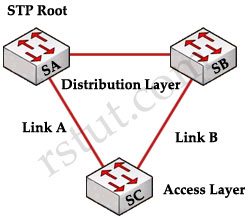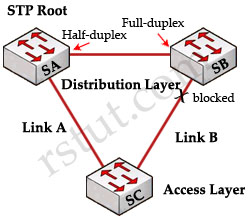Spanning Tree Protocol 2
Here you will find answers to Spanning Tree Protocol Questions – Part 2
Question 1
Which standard supports multiple instances of spanning tree?
A. 802.1 D
B. 802.1s
C. 802.1w
D. 802.1 z
Answer: B
Question 2
Spanning Tree Protocol calculates path cost based on which of these?
A. interface bandwidth
B. interface delay
C. interface bandwidth and delay
D. hop count
E. bridge priority
Answer: A
Question 3
In Layer 2 topologies, spanning-tree failures can cause loops in the network. These unblocked loops can cause network failures because of excessive traffic. Which two Catalyst 6500 features can be used to limit excessive traffic during spanning-tree loop conditions? (Choose two)
A. loop guard
B. storm control
C. storm suppression
D. broadcast suppression
E. BPDU guard
Answer: B D
Question 4
Why does RSTP have a better convergence time than 802.1 D?
A. it is newer
B. it has smaller timers
C. it has less overhead
D. it is not timer-based
Answer: D
Question 5
Under which two circumstances would an RSTP bridge flush its CAM table? (Choose two)
A. upon a port state change
B. upon receiving a topology change notification
C. when transitioning from discarding to forwarding
D. when transitioning from forwarding to discarding
E. only when changing from listening to discarding
F. when CAM resources have been completely used up
Answer: B C
Question 6
Which of these correctly identifies a difference between the way BPDUs are handled by 802.1w and 802.1 D?
A. 802.1D bridges do not relay BPDUs.
B. 802.1w bridges do not relay BPDUs.
C. 802.1D bridges only relay BPDUs received from the root.
D. 802.1w bridges only relay BPDUs received from the root.
Answer: C
Question 7
You have done a partial migration from 802.1 D STP to 802.1w STP. Which of the following is true?
A. 802.1 D and 802.1w intemperate only when the 802.1 D STP domain supports rapid convergence.
B. Ports leading to 802.1 D devices will run in compatibility mode, while the rest of the ports will run in 802.1 w mode.
C. This is an invalid configuration and a partial migration cannot be done.
D. The bridge timers will be set to match the 802.1 D devices.
E. A secondary root bridge will always be populated within the 802.1 D domain.
F. If the root bridge is selected within the 802.1 D domain, the whole STP domain will run in
Answer: B
Question 8
In the following network topology, there are three switches. All of them are configured to run STP. The network administrator has configured all switches in order for Link A to be the active link and Link B to be the standby link. When SB begins forwarding on Link B, a routing loop is formed. Why?

A. MISTP is enabled without RSTP.
B. There is a port duplex mismatch.
C. A single instance of STP is enabled instead of PVST.
D. PortFast is not enabled.
Answer: B
Explanation
When the network converges, link B will be blocked at one end. In this case, we suppose the port on SB is being blocked then it is still in blocking state until it stops receiving BPDU from a bridge that has a higher priority (in this case SA or SC). A port duplex mismatch can cause this state when the two endpoints of the connection between switch-switch are using different duplex settings. For example, one endpoint is operating at full-duplex while the other is using half-duplex. For example, the SA’s port connected to SB is set as “half-duplex” while SB’s port connected to SA is set as “full-duplex” as shown below.

Because switch SB has configuration for full-duplex, it does not perform carrier sense before link access. Switch SB starts to send frames even if switch SA is already using the link. Switch A, operating at half-duplex mode, detects a collision and runs the backoff algorithm before the bridge attempts another transmission of the frame. If there is enough traffic from SB to SA, every packet that A sends, which includes the BPDUs, undergoes deferment or collision and eventually gets dropped. SB does not receive BPDUs from SA any more, SB think it has lost the root bridge. This leads SB to unblock the port connected to SC, which creates the loop.
Some of the situations in which the loss of BPDUs cause a blocked port to go into forwarding mode are:
+ Duplex Mismatch
+ Unidirectional Link
+ Packet Corruption
+ Resource Errors
+ PortFast Configuration Error
+ Awkward STP Parameter Tuning and Diameter Issues
+ Software Errors
(Reference: http://www.cisco.com/en/US/tech/tk389/tk621/technologies_tech_note09186a00800951ac.shtml)

Q.6 ans should be B & C.
Q6 – shouldn’t the answer be B?. In 802.1D a TCN BPDU will be relayed up to the root, so C isn’t always true. B looks like it’s always true.
I second that.RSTP enabled bridges doesn’t relay BPDUs.
So B.
Q6: answer should be C:
BPDU’s handling is different in each protocol – in STP only the root port injects BPDUs to the network ,while in RSTP all the bridges that participates in the tree generates BPDUs.
Some one has posted really good info on the link below.
http://cciethebeginning.wordpress.com/2008/11/20/differences-between-stp-and-rstp/
For Q6 B and C are equally true and false. B is only not true during the initial election. C is not true for Topology Changes. Terrible if you get questions like this on the exam.
Document ID: 12013
QUOTE
Once the root is aware that there has been a topology change event in the network, it starts to send out its configuration BPDUs with the topology change (TC) bit set. These BPDUs are relayed by every bridge in the network with this bit set. As a result all bridges become aware of the topology change situation and it can reduce its aging time to forward_delay. Bridges receive topology change BPDUs on both forwarding and blocking ports
UNQUOTE
@Henk,
I agree with you, these are both true! I would hate to get this in the exam!
sdas
I’d come to see eye to eye with you one this subject. Which is not sotnmhieg I usually do! I love reading a post that will make people think. Also, thanks for allowing me to comment!